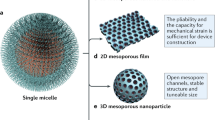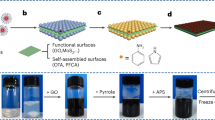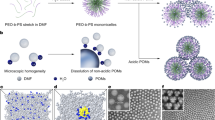Abstract
Supported mesostructured thin films are of major importance for applications in optical, electrochemical and sensing devices. However, good performance is restricted to mesostructured phases ensuring good accessibility from the film surface, which would be straightforward with cylindrical pores oriented normal to the underlying support, but this remains challenging. Here, we demonstrate that electrochemistry is likely to induce self-assembly of surfactant-templated (organo)silica thin films on various conducting supports, homogeneously over wide areas. The method involves the application of a suitable cathodic potential to an electrode immersed in a surfactant-containing hydrolysed sol solution to generate the hydroxyl ions that are necessary to catalyse polycondensation of the precursors and self-assembly of hexagonally packed one-dimensional channels that grow perpendicularly to the electrode surface. The method is compatible with controlled and localized deposition on heterogeneous supports, opening the way to electrochemically driven nanolithography for designing complex patterns of widely accessible mesostructured materials.
This is a preview of subscription content, access via your institution
Access options
Subscribe to this journal
Receive 12 print issues and online access
$259.00 per year
only $21.58 per issue
Buy this article
- Purchase on Springer Link
- Instant access to full article PDF
Prices may be subject to local taxes which are calculated during checkout





Similar content being viewed by others
References
Kresge, C. T., Leonowicz, M. E., Roth, W. J., Vartuli, J. C. & Beck, J. S. Ordered mesoporous molecular sieves synthesized by a liquid-crystal template mechanism. Nature 359, 710–712 (1992).
Braun, P. V. in Nanocomposite Science and Technology (eds Ajayan, P. M., Schadler, L. S. & Braun, P. V.) 155–214 (Wiley-VCH Verlag GmbH & Co. KGaA, Weinheim, 2003).
Sanchez, C., Julian, B., Belleville, P. & Popall, M. Applications of hybrid organic-inorganic nanocomposites. J. Mater. Chem. 15, 3559–3592 (2005).
Scott, B. J., Wirnsberger, G. & Stucky, G. D. Mesoporous and mesostructured materials for optical applications. Chem. Mater. 13, 3140–3150 (2001).
Hartmann, M. Ordered mesoporous materials for bioadsorption and biocatalysis. Chem. Mater. 17, 4577–4593 (2005).
Hoffmann, F., Cornelius, M., Morell, J. & Froeba, M. Silica-based mesoporous organic-inorganic hybrid materials. Angew. Chem. Int. Edn 45, 3216–3251 (2006).
Ogawa, M. Mesoporous silica films by supramolecular templating approach. Curr. Top. Colloid Interface Sci. 4, 209–217 (2001).
Nicole, L., Boissiere, C., Grosso, D., Quach, A. & Sanchez, C. Mesostructured hybrid organic-inorganic thin films. J. Mater. Chem. 15, 3598–3627 (2005).
Chao, K.-J., Liu, P.-H. & Huang, K.-Y. Thin films of mesoporous silica: Characterization and applications. C. R. Chim. 8, 727–739 (2005).
Yang, H., Coombs, N., Sokolov, I. & Ozin, G. A. Free-standing and oriented mesoporous silica films grown at the air–water interface. Nature 381, 589–592 (1996).
Schacht, S., Huo, Q., Voigt-Martin, I. G., Stucky, G. D. & Schuth, F. Oil-water interface templating of mesoporous macroscale structures. Science 273, 768–771 (1996).
Yang, H., Kuperman, A., Coombs, N., Mamiche-Afara, S. & Ozin, G. A. Synthesis of oriented films of mesoporous silica on mica. Nature 379, 703–705 (1996).
Lu, Y. et al. Continuous formation of supported cubic and hexagonal mesoporous films by sol–gel dip-coating. Nature 389, 364–368 (1997).
Brinker, C. J., Lu, Y., Sellinger, A. & Fan, H. Evaporation-induced self-assembly. Nanostructures made easy. Adv. Mater. 11, 579–585 (1999).
Grosso, D. et al. Fundamentals of mesostructuring through evaporation-induced self-assembly. Adv. Mater. 14, 309–322 (2004).
Soler-Illia, G. J. A. A. & Innocenzi, P. Mesoporous hybrid thin films: The physics and chemistry beneath. Chem. Eur. J. 12, 4478–4494 (2006).
Brinker, C. J. & Dunphy, D. R. Morphological control of surfactant-templated metal oxide films. Curr. Opin. Colloid Interface Sci. 11, 126–132 (2006).
Yang, H., Coombs, N. & Ozin, G. A. Thickness control and defects in oriented mesoporous silica films. J. Mater. Chem. 8, 1205–1411 (1998).
Song, C. & Villemure, G. Electrode modification with spin-coated films of mesoporous molecular sieve silicas. Micropor. Mesopor. Mater. 44–45, 679–689 (2001).
Fan, H. et al. Rapid prototyping of patterned functional nanostructures. Nature 405, 56–60 (2000).
Lu, Q., Gao, F., Komarneni, S. & Mallouk, T. E. Ordered SBA-15 nanorod arrays inside a porous alumina membrane. J. Am. Chem. Soc. 126, 8650–8651 (2004).
Yamaguchi, A. et al. Self-assembly of a silica-surfactant nanocomposite in a porous alumina membrane. Nature Mater. 3, 337–341 (2004).
Koganti, V. R. & Rankin, S. E. Synthesis of surfactant-templated silica films with orthogonally aligned hexagonal mesophase. J. Phys. Chem. B 109, 3279–3283 (2005).
Freer, E. M. et al. Oriented mesoporous organosilicate thin films. Nano Lett. 5, 2014–2018 (2005).
Fukumoto, H., Nagano, S., Kawatsuki, N. & Seki, T. Photo-alignment behavior of mesoporous silica thin films synthesized on a photo-cross-linkable polymer film. Chem. Mater. 18, 1226–1234 (2006).
Choi, K.-S., McFarland, E. W. & Stucky, G. D. Electrocatalytic properties of thin mesoporous platinum films synthesized utilizing potential-controlled surfactant assembly. Adv. Mater. 15, 2018–2021 (2003).
Shacham, R., Avnir, D. & Mandler, D. Electrodeposition of methylated sol-gel films on conducting surfaces. Adv. Mater. 11, 384–388 (1999).
Sibottier, E., Sayen, S., Gaboriaud, F. & Walcarius, A. Factors affecting the preparation and properties of electrodeposited silica thin films functionalized with amine or thiol groups. Langmuir 22, 8366–8373 (2006).
Bartlett, P. N., Birkin, P. R. & Ghanem, M. A. Electrochemical deposition of macroporous platinum, palladium and cobalt films using polystyrene latex sphere templates. Chem. Commun. 1671–1672 (2000).
Choi, K.-S., Lichtenegger, H. C., Stucky, G. D. & McFarland, E. W. Electrochemical synthesis of nanostructured ZnO films utilizing self-assembly of surfactant molecules at solid-liquid interfaces. J. Am. Chem. Soc. 124, 12402–12403 (2002).
Choi, Y.-K., King, T.-J. & Hu, C. Nanoscale CMOS spacer FinFET for the terabit era. IEEE Electron Device Lett. 23, 25–27 (2002).
Metz, S., Trautmann, C., Bertsch, A. & Renaud, P. Polyimide microfluidic devices with integrated nanoporous filtration areas manufactured by micromachining and ion track technology. J. Micromech. Microeng. 14, 324–331 (2004).
Xu, C. X., Zhang, X. S. & Sun, X. W. Preparation of porous alumina by anodization. J. Metastable Nanocryst. Mater. 23, 75–78 (2005).
Sato, H. & Homma, T. Fabrication of high-aspect-ratio arrayed structures using Si electrochemical etching. Sci. Technol. Adv. Mater. 7, 468–474 (2006).
Naik, S. P. et al. Phase and orientation control of mesoporous silica thin film via phase transformation. Thin Solid Films 495, 11–17 (2006).
Matheron, M. et al. Highly ordered CTAB-templated organosilicate films. J. Mater. Chem. 15, 4741–4745 (2005).
Etienne, M., Cortot, J. & Walcarius, A. Preconcentration electroanalysis at surfactant-templated thiol-functionalized silica thin films. Electroanalysis 19, 129–138 (2007).
Ryabov, A. D., Amon, A., Gorbatova, R. K., Ryabova, E. S. & Gnedenko, B. B. Mechanism of a “jumping off” ferricenium in glucose oxidase-D-glucose-ferrocene micellar electrochemical systems. J. Phys. Chem. 99, 14072–14077 (1995).
Massari, A. M., Gurney, R. W., Schwartz, C. P., Nguyen, S. T. & Hupp, J. T. Walljet electrochemistry: Quantifying molecular transport through metallopolymeric and zirconium phosphonate assembled porphyrin square thin films. Langmuir 20, 4422–4429 (2004).
Etienne, M. et al. Molecular transport into mesostructured silica thin films: Electrochemical monitoring and comparison between p6m, P63/mmc, Pm3n structures. Chem. Mater. 19, 844–856 (2007).
Etienne, M. & Walcarius, A. Evaporation induced self-assembly of templated silica and organosilica thin films on various electrode surfaces. Electrochem. Commun. 7, 1449–1456 (2005).
Moller, K. & Bein, T. Inclusion chemistry in periodic mesoporous hosts. Chem. Mater. 10, 2950–2963 (1998).
Walcarius, A. & Sibottier, E. Electrochemically-induced deposition of amine-functionalized silica films on gold electrodes and application to Cu(II) detection in (hydro)alcoholic medium. Electroanalysis 17, 1716–1726 (2005).
Sanchez-Rivera, A. E., Vital-Vaquier, V., Romero-Romo, M., Ramirez-Silva, M. T. & Palomar-Pardave, M. Electrochemical deposition of cetyltrimethylammonium surface hemimicelles at the Hg/0.1 M NaCl(aq) interface. J. Electrochem. Soc. 151, C666-C673 (2004).
Deepa, P. N., Kanungo, M., Claycomb, G., Sherwood, P. M. A. & Collinson, M. M. Electrochemically deposited sol-gel-derived silicate films as a viable alternative in thin-film design. Anal. Chem. 75, 5399–5405 (2003).
Burges, I. et al. Direct visualization of the potential-controlled transformation of hemimicellar aggregates of dodecyl sulfate into a condensed monolayer at the Au(111) electrode surface. Langmuir 15, 2607–2616 (1999).
Bard, A. J. & Faulkner, L. R. Electrochemical Methods: Fundamentals and Applications (Wiley, New York, 1980).
Shacham, R., Mandler, D. & Avnir, D. Electrochemically induced sol-gel deposition of zirconia thin films. Chem. Eur. J. 10, 1936–1943 (2004).
Shacham, R., Avnir, D. & Mandler, D. Electrodeposition of dye-doped titania thin films. J. Sol-Gel Sci. Technol. 31, 329–334 (2004).
Wang, D. et al. A general route to macroscopic hierarchical 3D nanowire networks. Angew. Chem. Int. Edn 43, 6169–6173 (2004).
Walcarius, A. Impact of mesoporous silica-based materials on electrochemistry and feedback from electrochemical science to the characterization of these ordered materials. C. R. Chim. 8, 693–712 (2005).
Walcarius, A., Mandler, D., Cox, J., Collinson, M. M. & Lev, O. Exciting new directions in the intersection of functionalized sol-gel materials with electrochemistry. J. Mater. Chem. 15, 3663–3689 (2005).
Angnes, L., Richter, E. M., Augelli, M. A. & Kume, G. H. Gold electrodes from recordable CDs. Anal. Chem. 72, 5503–5506 (2000).
Acknowledgements
This work was supported by the French National Research Agency (project No. NT05-3_41602 ‘mesoporelect’). We are also grateful to A. Kohler and S. Borensztajn for the SEM and FE-SEM experiments, respectively, and to C. Effoua for help with some of the experiments.
Author information
Authors and Affiliations
Contributions
A.W. was responsible for the project planning and data analysis, E.S. mainly contributed to the experimental work, M.E. carried out both experimental work and data analysis and J.G. obtained the TEM micrographs.
Corresponding author
Ethics declarations
Competing interests
The authors declare no competing financial interests.
Supplementary information
Supplementary Information
Supplementary figures S1-S6 (PDF 730 kb)
Rights and permissions
About this article
Cite this article
Walcarius, A., Sibottier, E., Etienne, M. et al. Electrochemically assisted self-assembly of mesoporous silica thin films. Nature Mater 6, 602–608 (2007). https://doi.org/10.1038/nmat1951
Received:
Accepted:
Published:
Issue Date:
DOI: https://doi.org/10.1038/nmat1951
This article is cited by
-
Recent Advances Ultra-Porous Drug Nano-Carriers: Synthesis and Targeting Approaches
Silicon (2024)
-
Mesoporous ZnO nanoparticles using gelatin — Pluronic F127 as a double colloidal system for methylene blue photodegradation
Korean Journal of Chemical Engineering (2023)
-
Electro-assisted self-assembly of mesoporous silica thin films: application to electrochemical sensing of glutathione in the presence of copper
Journal of Solid State Electrochemistry (2022)
-
Silica template as a morphology-controlling agent for deposition of platinum nanostructure on 3D-Ni-foam and its superior electrocatalytic performance towards methanol oxidation
Journal of Porous Materials (2021)
-
Amplified cathodic electrochemiluminescence of luminol based on zinc oxide nanoparticle modified Ni-foam electrode for ultrasensitive detection of amoxicillin
Journal of Solid State Electrochemistry (2021)



